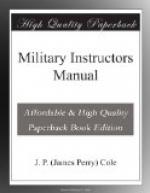Offensive Combat:
The attack develops into 2 parts.
(1) Assaulting hostile position
at selected points.
(2) Threaten or assault all other
parts of enemy line in order
to hold enemy from reinforcing operations.
Enveloping Attack:
Advantage of converging fire upon
position.
Holding Attack:
An attack for holding enemy in one
place, while assaults made at
another point.
Assaults:
The local concentrated offensive.
Pursuit:
Only by energetic pursuit can the
full fruit of victory be gleaned.
Its purpose is to cause the greatest loss in personnel
and morale
possible cavalry and artillery active.
Defensive Combat:
Passive defense—to gain
time, or to hold certain points pending
results in other parts of the line.
Defense seeking a favorable decision—a
parrying of blows while
seeking a favorable opening.
Counter attack the crisis of this
form.
Counter attack—made by
launching reserves at the flank, while the
enemy is fully committed to the attack.
Defensive Positions:
Requisites:
Clear field of fire.
Flanks naturally secure.
Extent of ground suitable
to strength of force.
Effective corps for
reserves.
Good lines of retreat.
Good communication.
Position in Readiness:
A position intended to resist the
advance of an enemy in the
immediate vicinity information of whose movements
is not full enough
to warrant definite action.
Withdrawal From Action:
Troops most readily disengaged from
the enemy should be withdrawn
first.
Demands highest order of skill in
troop leadership.
Covering Positions—those
positions chosen to cover the retreating
force.
Retreat—a step by step
opposition to the enemy’s advance on a
prearranged plan.
Delaying actions:
1. Advance
delayed as long as possible, consistent with safe
withdrawal.
2. Delayers
must hold position.
Night Combat:
Offensive advisable.
1. Where
fire superiority is impossible by day.
2. To avoid
heavy losses by advance to assaulting position by
day.
3. To capture
posts or patrols.
4. To surprise
for moral effect.
Defensive:
Obstacles in front of position.
Trenches heavily manned and supports
drawn close.
Shelter:
Troops under canvas—in
camp.
Troops on ground without canvas—bivouac.
Troops in huts or villages—cantonment.
Tactical considerations are paramount
in the selection of camp sites
in the theater of operations.
Selection of Camp Site:
1. Suitably large to accommodate
command.
2. Water supply sufficient
and accessible.
3. Good roads to and in camp.
4. Wood and grass forage near
at hand.
5. Sandy subsoil for drainage.
6. Hot weather shade—cold
protection.




